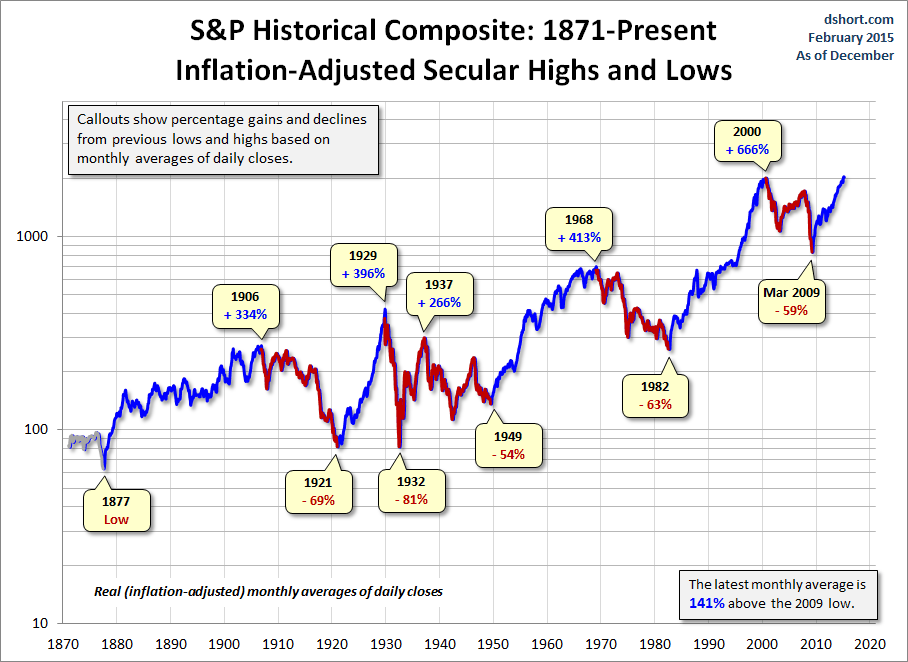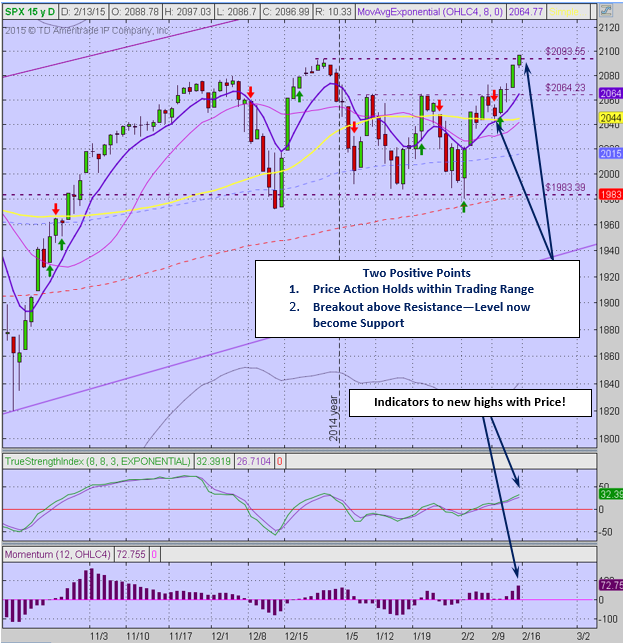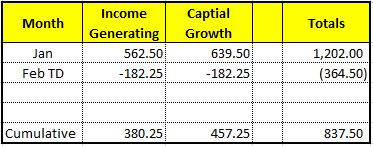Good Day Traders,
Well we are already half way through February and as many know this non-committal market has been challenging since about the mid-point of December 2015. Last week we had several questions about why we haven’t traded larger positions over the past weeks and the main reason is that the recent market environment has been very unpredictable and volatile. Yes the reward for guessing right about where the wind blows can be rewarding, but the punishment for being in the wrong place at the wrong time can be damaging! When the market is not cooperating with the kind of trades we’re looking for, it is a good time to sharpen the saw so we will be ready when the personality changes. I have no doubt that there will be ample opportunities in the near future for expanded number and size of trades!
Just after the market close on Friday I received a phone call that turned out to be a very pleasant surprise. During the Orlando trip I met one of the Senior Editors for Forbes online trading site. I asked him about becoming a Forbes contributor. He took my info and said we’ll check you out and get back to you. The call Friday was an invitation to become a Forbes contributor. There is not compensation just an opportunity to share about Technical Analysis and the Active Trend Trading System. Maybe it will help when I’ve finished the book.
Today’s Trader’s Report includes one of Mike’s overview of Secular Cycles. While we recognize that Price Action is always king, being aware of longer term cycles help us to be aware of where we are in that cycle. Mike—thanks for the insight.
Mike’s Macro Market Musings: What is Scott O’Neil Talking About?
In one of his recent weekly commentaries, Dennis mentioned having listened to Scott O’Neil (son of, and seeming heir apparent to, IBD founder William O’Neil) in a webinar and stating that there needs to be a substantial market correction of 20-25% (or more) before the next super market cycle can begin. What exactly is he talking about, and where is he coming from? Scott O’Neil, that is, not Dennis.
The answer isn’t complicated but it does require some historical reference and a long term time perspective. Over the past century or more, there have been recurrent longer term market cycles averaging 16-18 years in duration known as “secular” bull and bear cycles or markets, the term “secular” referring to the long term nature of these time periods. The best example of a secular bull market is the period from 1982-2000, a nearly 18 year period during which the Dow advanced from a peak of around 770 in 1982 to a peak of approximately 11,750 in early 2000 while the Nasdaq advanced from a low of 159 in late 1982 to a peak exceeding 5100 in early 2000. A period of time encompassing the advent of the personal computer and the internet and culminating in the “dot com boom” during which the financial markets could seemingly only go up. And a good example of a secular bear market could be considered to have happened from 1966-1982, the Dow having peaked in 1966 around 1000 and not appreciably progressing past that level until late in 1982, a period of 16 years or so when the Dow essentially went nowhere – this type of price action in the market indexes over this kind of time frame is almost the very definition of a secular bear market.
Of course, financial markets do not progress in straight lines in either direction. Secular bull markets are punctuated by periodic downdrafts followed by a series of higher highs and higher lows – there were several significant pullbacks during the secular bull market of 1982-2000, including the crash of October, 1987. And every secular bear market has been characterized by “cyclical” bull markets lasting 3-4 years which advance 100% or more off of preceding lows interspersed with cyclical bear markets that can last 1-2 years and shave 30-50% (or more) from preceding cyclical bull market highs. And, typically, secular bear markets are characterized by three of these cyclical bear markets before the secular bear cycle ends and segues into the next secular bull. Space here limits delving further into more nuanced considerations of secular markets, but these are applicable broad brush strokes that can help define them. And, while history doesn’t always repeat itself exactly, it often rhymes. As always, a picture can be worth a thousand words:
The key word on the chart above is secular. The implicit rule I’m following is that blue generally shows secular trends that lead to new all-time real highs. Periods in between are secular bear markets, regardless of their cyclical rallies. For example, the rally from 1932 to 1937, despite its strength, remains a cycle in a secular bear market. We may not yet be able to accurately characterize the period from the lows of March, 2009, as a cyclical or secular bull market in the overall scheme of things.
There is a widespread and common belief amongst many that, despite the awesome bull market off of the March, 2009, lows, that what we have experienced is nothing more than a cyclical bull market in the overall secular bear market that followed from the 2000 dot com peaks, one that has been extended in duration and magnitude by unprecedented central bank monetary policies. The best evidence and support for this belief is that the Nasdaq has essentially gone nowhere for the past 15 years overall, having peaked at over 5100 in 2000 and not yet having returned to that nominal level some 15 years later. Adjusted for inflation, the S&P 500 is now just about where it was 15 years ago at the peak in the year 2000.
So now we have an idea what Scott O’Neil is talking about. What he calls “the next super cycle” is just another way of saying “the next secular bull market”. And what he is really saying is that there needs to be another, or third, cyclical bear market to end the current secular bear market before the next secular bull market can get underway. We have had two significant sell offs since 2000 and we will need another one to relieve the excesses of the current cyclical bull market and get overall market valuations down to where prior secular bear cycles have ended and from which subsequent secular bulls have begun. Whether one agrees with him or not, this is what Scott O’Neil has been talking about, and where he is coming from.
General Market Observation: I’ll keep the Observation Short. The Indexes all showed some strength last week and all three tracking Indexes held their breakouts above past resistance. While this is good news, doing so the day before the start of a 3 day holiday weekend on less that aggressive volume keeps the news at the good not great level.
A positive sign for the Indexes that you will see many analyst talking about is the positive way each of the Indexes moved within their respective trading range this week. At the beginning of the week price pulled down from overhead supply/resistance but, and this is a big but—Price changed its personality and found support in the midsection of the range. This is usually an indication of at least short term strength that could lead to a more sustained move up. Add to this observation how the moving averages have now untangled and are not showing a positive demeanor is also a positive. The 8, 20 & 50 day moving averages on the RUT, NDX and SPX each look to be moving towards a bullish stack (short term averages above longer term averages) and slope (moving up). As the slope moves up it improves their ability to serve as support for pullbacks.
Remember for each of the Indexes the resistance which was broken on Friday now becomes a level of support and a line of demarcation we can plan trades around moving forward. The SPX chart below provide a view of the current positive clues.
_________________________________________________________
If you have not had a chance to check out the research Mike Trager and I have done to start the EWA service you can find a short 10 minute preview at: http://youtu.be/MgC9GMAWh4w
If simplifying your life by trading along with us using the index ETF is of interest you can get the full background video at: https://activetrendtrading.com/etf-early-warning-alerts-video/
Remember if you are a premium or Early Warning Alert member you can receive Text Alerts and Trade Notifications if you send us your mobile phone number. Sent us your number with NO HYPHENS please and we’ll get you on the Text Notification List.
The How to Make Money Trading Stock Show—Free Webinar every Friday at 10 a.m. PDT. This weekly live and recorded webinar helped traders find great stocks and ETF’s to trade with excellent timing and helped them stay out of the market during times of weakness.
The “How to Make Money Trading Stocks” Show is back this Friday, February 20th. Ensure you get a seat by registering now at: https://attendee.gotowebinar.com/register/3645531222019259393
To get notifications of the newly recorded and posted Market Stock Talk every week subscribe at the Market Tech Talk Channel: https://www.youtube.com/channel/UCLK-GdCSCGTo5IN2hvuDP0w
- The Active Trend Trader Affiliate Program is ready. For more information or to become an Affiliate please register here: https://activetrendtrading.com/affiliates-sign-up-and-login/
Summary of Monthly Closed Trades as of the Feb 13th:
Less than 1% invested.
Total Booked Profits since Jan 1 when the timing service began: $837.50
_______________________________________________________________
ATTS Returns for past 3 Years—Each account is now reset to $100K to begin 2015!
Since 2012 we have traded the Active Trend Trading System with the following net performance. Sharing this data is not a representation that similar results will continue in the future:
2012: 24.98%
2013: 41.1%
2014: 28.16%
Compounded Return = 126% for the three years or an average of 31.41%/Year
Active Trend Trading’s Yearly Objectives:
– Yearly Return of 40%
– 60% Winning Trades
For a complete view of specific trades closed visit the website at: https://activetrendtrading.com/current-positions/
Updated at the beginning of each month.
Managing Existing Trades: We closes out of AMBA on Friday when our stop loss was hit just below support. Depending on where a trader’s broker got them out the total loss was between 4.3% and 5.8%. Slippage like this is very real and happens when price move quickly down! If someone did not have a hard stop in place at the low of the day the loss was sitting over -11%. Risk management calls us to follow our rules and while price on AMBA may set up for a bounce off support at the 100 day SMA selling at a higher level proved to be a wise move saving between 5%-6% move downside.
Because we traded AMBA for a great profit earlier in the year the traded position is still positive for the year. The stock remains on our buy watch list but must prove itself again after Friday meltdown.
NOAH came within 3 cents of hitting our first profit target at $22. If traders chose to take some profit as price action pulled down from this level that decision is great. Each of us must determine where to draw our own personal line in the sand! The daily and weekly chart on NOAH looks positive but we keep in mind that earnings are scheduled on 2/26 After Market Close (AMC) so our current plan it take profit at $22 and then close the remaining shares prior to the close no later than 2/26/15. If price gaps above $22 on Tuesday a 25-50 cent trailing stop will be put in place to replace the $22 target. An alert will be forth coming if the pre-market on Tuesday looks positive. Current the profit on NOAH is 5%.
Pre-Earnings Trade: With Earnings Season about half way over two stocks that may provide some fireworks this week are CAR and PCYC. Neither are true market movers so their earning will not have a major impact on the overall market.
Potential Set Ups for this week: Each week in this section stocks with promising patterns are highlighted. We may or may not issue trading alerts on these stocks. The intent of providing this refined list is for individual members to track and apply the ATTS rules for potential trades. Our process of stock review includes chart analysis of stocks that meet IBD growth stock criteria.
Upside: Several candidates are at various points as they move on a positive trajectory. These include: XRS, VDSI**, INCY, NOAH, AFSI, SCOR and ALK**. ALK is at the 50 day with a good flag set up.
Downside: News out on BABA that they are under investigation may lead to more downside this week. Kind of interesting that the selloff of this highflyer started several weeks ago—do you think someone may have known something? BIDU is also looking weak. These are both Chinese Internet stocks.
Toss Ups: Some of the following stocks have earnings within the next 3 weeks and could provide earnings runs. Stocks of Interest are, HABT, GLOG, AMBA, SWI, CELG and SNCR.
Coming on the Radar: The following stocks are starting to stand out in some of the Market Smith sorts. They are HAIN and CAVM.
Mid-week I’ll be highlighting some IPO’s that are setting up as a new feature for Active Trend Traders.
Leveraged Index ETFs: All four ETFs we track are extended away from proper entry action points. TQQQ and SPXL are tracking closest to their underlying Index.
Comments and opinions written below this line of text may be provocative and only obliquely related to trading. Some may find these “Off the Wall” comments challenging to their outlook on life. I will not post any comments made on subject matter below this line, so if you disagree blast away.
OFF THE WALL
Off the Wall: Happy President’s Weekend! Do politics and news sway your trading decisions? If they do then you may have a tendency to be an impulsive trader! For rule based trading there is no room for impulsiveness! If we tend to be politically oriented we can get emotional when we sense that our core beliefs are being violated by our elected officials or a particular party. The emotions can take an opposite course when we fill that our particular views are winning the day politically. Both emotional outlets either anger or joy can challenge our ability to analyze opportunity and follow our rules!
The sources which provide triggers causing us to emote must be managed well to assure the noise coming out is muted. The main reason for this is to keep us from getting stuck in the “what if’s”. Like what if a deal can’t be worked out with Greece? If we dwell on that question and it festers in our minds we will find many reasons to take action or to not take action. If emotions are involved typically which ever action we take will be flawed. So what’s a trader to do?
Several actions have helped me mute the noise. First turn off the noise during two very important periods—when I do my analysis and during live market hours. Secondly ask myself the question when I do read or hear a story—Is it news or noise? Lastly I must commit to the overarching rule of the market “Price is king!” Understanding price action will normally provide the clues we need for successful trades regardless of what the talking heads are spitting out!
Share Your Success: Many of you have sent me notes regarding the success you are having with the Active Trend Trading System. Please send your stories to me at dww@activetrendtrading.com or leave a post on the website. Thanks!




